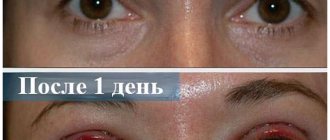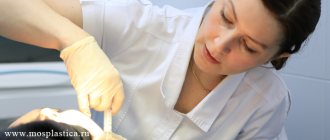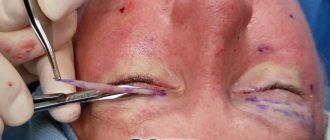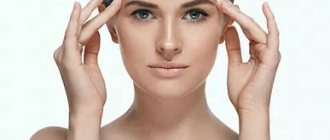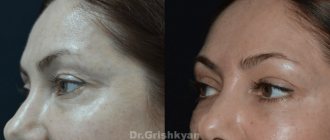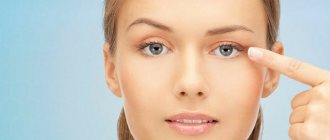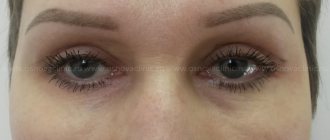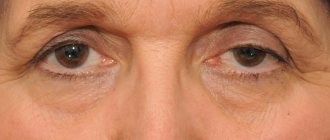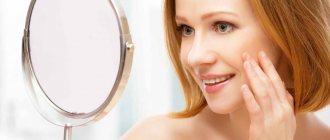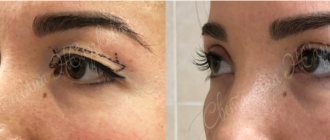Rehabilitation after blepharoplasty is usually quick and easy. It is necessary to follow all the recommendations of the plastic surgeon, and then after 2-3 weeks. you can return to your normal lifestyle.
Rehabilitation calendar after surgery by day
Swelling and bruising after blepharoplasty
Scars (scars) after blepharoplasty of the upper and lower eyelids
Limitations after blepharoplasty
Care after blepharoplasty of the upper and lower eyelids
Rehabilitation calendar after blepharoplasty by day
immediately after surgery
At the end of the operation, strips are glued to the eyelid area, and the patient is transferred to a ward, where ice is applied to the periorbital area to reduce swelling.
photo immediately after upper blepharoplasty surgery
As a rule, there is no pain after blepharoplasty. After 1-2 hours the patient is discharged for outpatient observation by a surgeon
first day
On the first day after surgery, the patient is bandaged. On days 1-2-3, swelling begins to increase. It is necessary to make cold lotions with antiseptics.
second day
On the 2nd day in the morning, you can take a single diuretic tablet (only as prescribed by your doctor) to reduce swelling. ъ
the third day
Swelling on day 3 is usually maximum. You are allowed to shower and wash your hair.
fourth day
On the 4th day, the swelling begins to gradually decrease, and the tension in the eyelids goes away.
5 day
During this period, the strips and stitches from the eyelids are removed.
6th day
After the stitches are removed, the strips are stuck on for a few more days.
7th day
By this time, the bruises are almost completely gone, the swelling is significantly reduced.
After a week, the most noticeable swelling in patients goes away, and you can already go to work, although it is optimal to stay at home for up to 2 weeks.
9th day
At this time the strips are completely removed
The swelling is significantly reduced. The suture line is reddish. You can start using cosmetics.
2 weeks
Even at this time, the redness begins to gradually decrease, the swelling continues to decrease.
in three weeks
There is no longer any visible swelling and bruising, patients come to the clinic for routine dressing changes, and they can slowly resume light sports activities.
a month later
You can return to full physical activity.
2, 3, 6 and 12 months
Scheduled control inspections are carried out. They assess the condition of the scars.
Don't strain your eyes
Another group of prohibitions concerns gadgets, TV and even books.
Once during a consultation I was asked: “What, after blepharoplasty I shouldn’t look at my phone, play on a tablet or even watch TV for a month?!”
Of course not! We are talking about the need to reduce contact with technology and books, and not about a complete ban.
Firstly, our age involves close contact with gadgets. There is no escape from it.
Secondly, there is no point in a complete ban. We are not restoring vision, but removing imperfections of a different kind.
You just need to use smartphones minimally. Don’t scroll through the news feed for an hour, don’t watch TV series, don’t read e-books.
Your eyes need rest.
Swelling and bruising after blepharoplasty
After almost any operation, swelling and bruising occur in the area of surgical trauma due to the intersection of blood and lymphatic vessels. All patients are concerned about the question of when the swelling and bruising will go away after blepharoplasty, how long they last and how to remove them. As can be seen from the rehabilitation calendar, during the first 3 days the swelling increases and then begins to gradually subside. By 2-3 weeks, most patients already have a presentable appearance. The swelling completely subsides by 6 months. A number of remedies can help remove dark circles under the eyes and swelling:
Lyoton
Gel for external use.
Direct anticoagulant for external use, which has a local antithrombotic, antiexudative, moderate anti-inflammatory effect, accelerates the processes of resorption of hematomas and blood clots and reduces tissue swelling.
traumeel
Ointment for external use. A multicomponent homeopathic medicine, the effect of which is determined by the components included in its composition.
troxevasin
Troxevasin® is a flavonoid (rutin derivative). Has P-vitamin activity; has venotonic, venoprotective, decongestant, anti-inflammatory, anticoagulant and antioxidant effects. Reduces the permeability and fragility of capillaries, increases their tone.
Microcurrents
Microcurrent procedures improve blood microcirculation. The number of sessions is 10–20 with an interval of 1–2 days. The process involves exposure to low frequency currents. As a result of this action, the production of collagen and elastin is stimulated and skin elasticity increases.
Microcurrent therapy stimulates pain-inhibiting nerve cells through the production of endogenous opioid neuropeptides with analgesic effects.
When carrying out MT in the early postoperative period, complex techniques are used, which include magnetic laser exposure and ozone therapy.
Scars (scars) after blepharoplasty of the upper and lower eyelids
Many patients have a question: do scars remain after surgery? Of course they remain. But you shouldn’t be scared, since they are practically invisible and look like a thin strip, and with transconjunctival blepharoplasty they are not there at all.
The next reasonable question is how to remove scars?
It is impossible to completely remove scars; you can make them almost invisible. And for this, after the operation it is necessary to undergo special treatment. And then patient reviews on the quality of scars after blepharoplasty will be 99.9% positive.
photo scars / scars after upper/lower blepharoplasty
And one more question that concerns patients: what should they use to smear the scars after surgery so that they are invisible? Let’s look at these remedies and scar treatment in more detail.
Scar treatment
There are a huge number of different scar care products, including various drugs:
Gel after blepharoplasty
contractubex
It is a combined preparation in the form of a gel, the effect of which is determined by the properties of its constituent components: Allantoin, Heparin sodium, Onion. It has fibrinolytic, anti-inflammatory (due to the extract of Serae bulbs), antithrombotic (due to heparin), and keratolytic effects (due to allantoin). Causes stimulation of cellular regeneration without hyperplasia. Prevents the formation of keloid scars by inhibiting fibroblasts.
dermatix
The drug is in the form of a silicone gel for external use, transparent, colorless and odorless. Consists of a mixture of polymeric organosilicon compounds (polysiloxanes). Helps maintain uniform moisture in the eyelid skin, has a corrective effect on scars after upper and lower blepharoplasty, smoothing and softening them, relieves pain, itching and discomfort, and also reduces skin redness.
Silicone patch
Silicone patches are also a large group of scar care products. But when applied to eyelids, they are not entirely comfortable. The most famous companies on the Russian market are Dermatix and Mepiform.
Enzyme preparations
A group of drugs intended for the treatment of hypertrophic and keloid scars.
longidase
Longidase is a drug whose main active ingredient is the enzyme hyaluronidase. This enzyme
- increases the permeability of connective tissue;
- stops the process of gross scarring by reducing the formation of its own collagen in the cells of the dermis;
- increases the level of elasticity of the skin of the eyelids.
The drug is available in the form of a dry substance in ampoules. Before use, it is dissolved in 2 ml of liquid (saline or 0.25% lidocaine solution) and injected directly into the scar with a needle.
lidase
An enzyme preparation whose main active ingredient is hyaluronidase.
It is known that hypertrophic and keloid scars are formed due to excessive synthesis of hyaluronic acid. With its participation, at an early stage of the wound process, the production of fibroblasts is stimulated, which produce new skin cells in huge quantities.
When lidase is introduced, excess hyaluronic acid is eliminated, since lidase acts on this acid and decomposes it into glucosamine and glucuronic acid. As a result, microcirculation and cell permeability improve in the scar area.
Available in ampoules as a lyophilisate. Before use, like longidase, it is dissolved in saline and injected under the problematic scar. If injections of the drug are painful, it is better to dissolve it in a lidocaine solution.
imoferase
Eye cream after blepharoplasty, like Lidaza, contains the active ingredient Hyaluronidase, which suppresses the growth of connective tissue and reduces swelling.
With a course of treatment, raised scars decrease in volume, pigmentation decreases, and the elasticity of the eyelid skin increases.
A good property of Imoferase Cream is its ability to act on old scars and scars, reducing their density.
Hormonal ointments and suspensions
hydrocortisone
Hydrocortisone ointment has an anti-inflammatory effect and inhibits the growth of connective tissue. It is used after blepharoplasty and eyelid pathology. Hydrocortisone is a glucocorticosteroid, the use of which can cause many side effects. Therefore, the drug can be used only when prescribed by a doctor.
diprospan
The main active substance is the glucocorticosteroid betamethasone, the effect of which is that it stops the pathological growth of scar tissue, causing the scar to become smaller and flatter. The main indication for use is keloid scars. Uncontrolled use can cause tissue atrophy.
After blepharoplasty it is practically not used
Limitations after blepharoplasty
After blepharoplasty, it is necessary to follow the recommendations for a restrictive regime. Below are the dos and don'ts after surgery:
sports and physical activity
During consultations, I always tell you in detail when you can start playing sports after blepharoplasty. In the first days, it is better to avoid any exercise, as this can lead to an increase in blood pressure and provoke bleeding. A home regimen for 2-3 days is recommended. As a rule, after a month you can fully start playing sports and fitness.
solarium
You can visit the solarium 1 month after blepharoplasty, but be sure to cover the eyelid area, otherwise persistent hyperpigmentation may appear.
alcohol and smoking
Many patients are concerned about when they can drink alcohol and smoke cigarettes after blepharoplasty. It’s better not to drink or smoke at all and say “no” to bad habits! But if you really want to, then no earlier than 2 weeks, as they negatively affect healing.
Tan
You can sunbathe in the sun after 1 month, but you need to use sunscreen, otherwise you can get persistent hyperpigmentation
makeup
Many people are interested in when they can paint their eyes after blepharoplasty. Makeup (cosmetics) can be applied within 5-7 days after surgery. It is necessary to pay attention to any redness, and if it appears, you need to remove makeup so as not to provoke an allergic reaction.
Job
You can return to work 3-5 days after blepharoplasty. But if possible, it is optimal to stay at home for 2 weeks.
eyelashes and tattoo
You can get eyelash extensions 1 month after eyelid surgery. Tattooing can be done 1 month after surgery.
lenses and vision
Lenses after upper blepharoplasty can be put on immediately, and after transconjunctival blepharoplasty - after 10-14 days. For a period of up to 2 weeks, it is necessary to exclude working on the computer and phone, reading books, watching TV and giving your eyes rest.
Botox and Dysport
Botox or Dysport can be injected 1 month after blepharoplasty.
sex
There are no strict restrictions on sex
How to speed up healing?
First of all, strictly follow all the instructions and recommendations of your surgeon. Following medical instructions is the main task of the patient, who strives to recover as quickly as possible. It is necessary to follow the prescribed dosages of medications and ointments and the regimen for caring for the injured area. Some drugs or their components can cause an allergic reaction, so you should not prescribe medications yourself. Only a surgeon can tell you what to coat the sutures after blepharoplasty.
It is also necessary to follow the prohibitions established by the surgeon. This is, first of all, protection from bending over and any actions that cause a rush of blood to the head, protection from ultraviolet rays, exclusion of sports and physical activity, visits to the bathhouse, sauna and swimming pool. Following the rules and prohibitions will help the tissues heal faster and make rehabilitation easier.
Care after blepharoplasty of the upper and lower eyelids
After blepharoplasty, patients are prescribed various medications (for example, antibiotics) and undergo physiotherapeutic treatment (lymphatic drainage massage, microcurrents, electrophoresis and ultrasound) for quick recovery.
The speed of rehabilitation after blepharoplasty depends on proper care of the surgical area. It includes a set of measures affecting the skin of the eyelids, suture lines and eyes. It’s worth looking at this in more detail:
seam care
Immediately after the operation, a special patch is glued to the suture area - strips, which act as a protective bandage. They are removed after 5-7 days. For a week, it is necessary to treat the suture line with antiseptics, for example, an alcohol solution of chlorhexedine and apply cool lotions with furatsilin 5-6 times a day for 15 minutes, 3-4 days, then less often, 3-4 times a day (you can use cool bags of brewed tea, medicinal herbs - chamomile, St. John's wort).
eye care
The eyes are not injured in any way during the operation, so they do not require special care. However, wearing lenses is avoided to avoid causing irritation. Very often after blepharoplasty, symptoms in the eye area such as irritation, itching, dryness and redness may be observed.
If the above symptoms occur, you must use special eye drops. They will help you quickly and painlessly get rid of unpleasant manifestations. The most common drugs include:
- Artificial tear;
- Tobrex;;
- Systane.
upper and lower eyelid care
pursues the following goals:
- protects seams from contamination
- accelerates the resolution of edema
- stimulates the wound process and rapid healing
In addition to the recommendations of the plastic surgeon, in the postoperative period, you can perform a special set of exercises for the eyes, which is necessary to improve blood supply to the surgical area, to accelerate the resolution of swelling and reduce the inflammatory process.
Self-massage also helps in restoring the periorbital area. The essence of the massage is that point circular pressure is applied with the fingers in the eyelid area.
Prohibitions to implement
In some cases, massage is not recommended and can lead to negative consequences.
- aggravated form of herpes;
- allergic reactions in the facial area;
- the presence of papillomas, warts, large moles;
- increased skin sensitivity;
- fragility of blood vessels;
- inflammation on the skin. In this case, the infection may spread to other areas;
- hemangiomas and rosacea;
- epilepsy;
- the presence of enlarged lymph nodes below the jaw or on the neck;
- neuritis of the facial nerve;
- hemophilia;
- tendency to nosebleeds;
- high or low blood pressure
